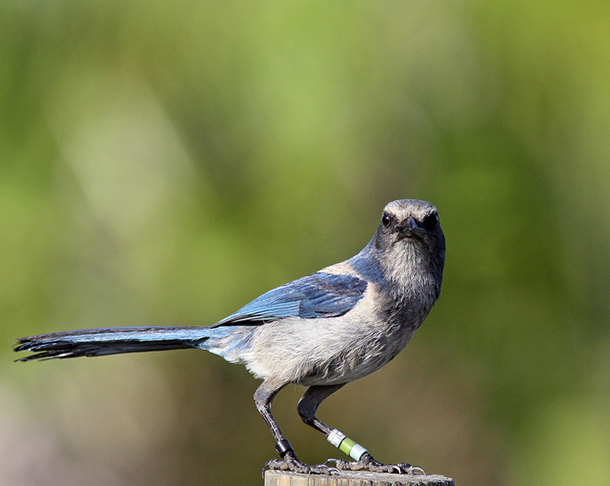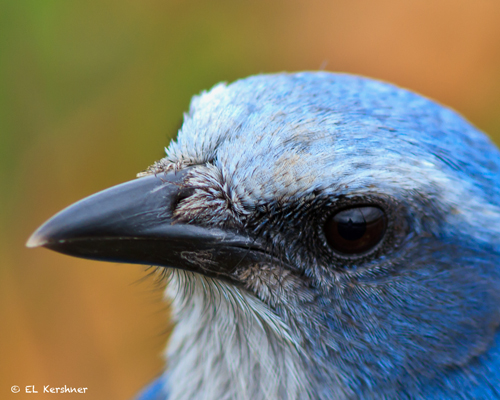BirdNote: The Florida Scrub-Jay
Air Date: Week of March 18, 2016

The Florida Scrub-Jay evolved in a time of higher sea levels, when the Florida peninsula was isolated as an island. (Photo: Dan Irizarry)
Thousands of years ago, higher sea levels isolated much of Florida from the mainland, and the Florida Scrub-Jay evolved into a unique species found nowhere else. BirdNote’s Michael Stein reports on the habits of this rare bird and the threat of habitat destruction that it faces.
Transcript
BIRDNOTE®/SCRUB-JAY
[MUSIC - BIRDNOTE® THEME]
CURWOOD: Off to Florida now – where the seas are rising and much of the land is vulnerable. And as Michael Stein explains in this BirdNote®, one unique ecosystem is especially under threat.
BirdNote®
The Florida Scrub-Jay
[Florida Scrub-Jay calls]
STEIN: One of the rarest natural habitats in America is found in Florida. Thousands of years ago, rising sea levels isolated much of the Florida peninsula as an island. During that long isolation, a unique oak-scrub ecosystem developed. The Florida Scrub-Jay is one among many special animals and plants that evolved with this habitat now protected by the Archbold Biological Station.
[Florida Scrub-Jay calls]

Florida Scrub-Jays live in family groups, and the young of the previous year help raise their younger siblings. (Photo: Eric Kershner)
Eastern Towhees [Eastern Towhee (Florida subspecies) song] and Loggerhead Shrikes are common in the dense scrub habitat [juvenile Loggerhead Shrikes calling]. But unlike the towhee and the shrike, Florida Scrub-Jays are found nowhere else.
Because they’re fascinating birds and quite tame around humans, the jays have been studied for many years. They live in family groups, the young of the previous year helping to raise the current young. This altruistic behavior seemed surprising until studies with banded birds showed that one of the young would immediately take the place of an adult that died.
[Florida Scrub-Jays calling]
Because they depend on acorns during winter, Florida Scrub-Jays can survive only
in oak scrub. Populations have declined by 90% because the birds have lost much of their special habitat to citrus groves, pastures, and development. Now people are working hard to protect what remains.
[Florida Scrub-Jay calls]
I’m Michael Stein.
CURWOOD: For pictures, head on over to our website, LOE.org.
###
Written by Dennis Paulson
Bird sounds provided by The Macaulay Library of Natural Sounds at the Cornell Lab of Ornithology, Ithaca, New York. Calls of Florida Scrub-Jay [138375] recorded by G.F. Budney and [105737] by G.A. Keller; Call notes from Eastern Towhee [105381] recorded by G.A.Keller; and Loggerhead Shrike [105710] recorded by G.A. Keller; group of Florida Scrub-Jays calling [13036] at Archbold Station by K. Worden.
Producer: John Kessler
Executive Producer: Chris Peterson
© Tune In to Nature.org March 2016 Narrator: Michael Stein
A good discussion of Florida Scrub-Jay conservation is at the University of Florida IFAS Extension website (http://edis.ifas.ufl.edu/uw306).
http://birdnote.org/show/florida-scrub-jay
Links
The Florida Scrub-Jay on BirdNote
The Florida Scrub-Jay: A Species in Peril”
About the Florida Scrub-Jay, from the Cornell Lab of Ornithology
Living on Earth wants to hear from you!
Living on Earth
62 Calef Highway, Suite 212
Lee, NH 03861
Telephone: 617-287-4121
E-mail: comments@loe.org
Newsletter [Click here]
Donate to Living on Earth!
Living on Earth is an independent media program and relies entirely on contributions from listeners and institutions supporting public service. Please donate now to preserve an independent environmental voice.
NewsletterLiving on Earth offers a weekly delivery of the show's rundown to your mailbox. Sign up for our newsletter today!
 Sailors For The Sea: Be the change you want to sea.
Sailors For The Sea: Be the change you want to sea.
 Creating positive outcomes for future generations.
Creating positive outcomes for future generations.
 Innovating to make the world a better, more sustainable place to live. Listen to the race to 9 billion
Innovating to make the world a better, more sustainable place to live. Listen to the race to 9 billion
 The Grantham Foundation for the Protection of the Environment: Committed to protecting and improving the health of the global environment.
The Grantham Foundation for the Protection of the Environment: Committed to protecting and improving the health of the global environment.
 Contribute to Living on Earth and receive, as our gift to you, an archival print of one of Mark Seth Lender's extraordinary wildlife photographs. Follow the link to see Mark's current collection of photographs.
Contribute to Living on Earth and receive, as our gift to you, an archival print of one of Mark Seth Lender's extraordinary wildlife photographs. Follow the link to see Mark's current collection of photographs.
 Buy a signed copy of Mark Seth Lender's book Smeagull the Seagull & support Living on Earth
Buy a signed copy of Mark Seth Lender's book Smeagull the Seagull & support Living on Earth

